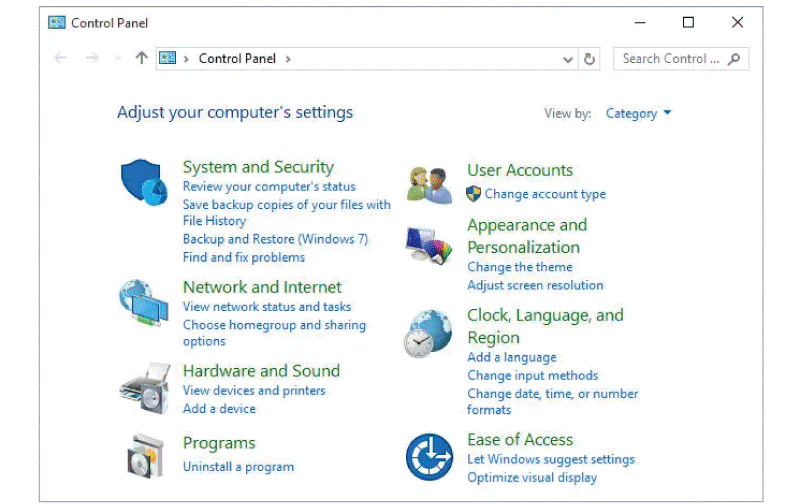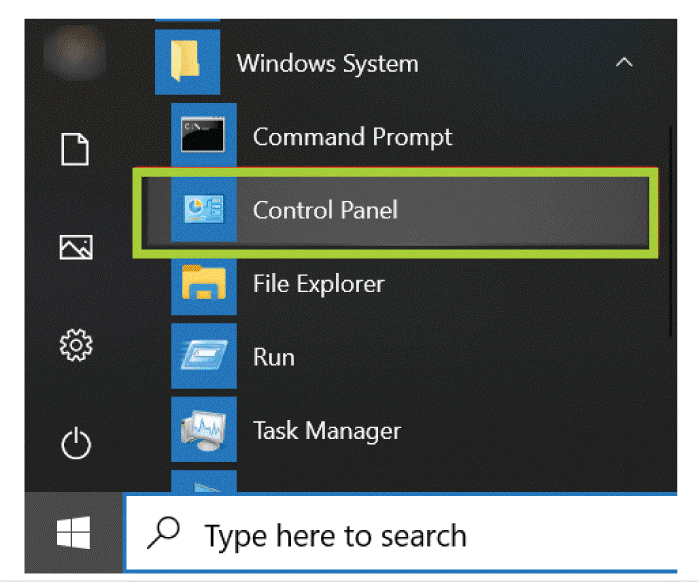How to Open the Windows Control Panel?
The Control Panel is a central position in Microsoft Windows where you can access and adjust various system settings. You can utilize one of the following methods to open the Window Control Panel:
1. Click the Windows key + X on your keyboard. This will open the Quick Link menu, from which you can select "Control Panel."
2. Click the Windows key + R on your keyboard to open the Run dialog box. Type "control" and press Enter. This will open the Control Panel.
3. Press the Start button, & then click the gear icon (Settings) on the left side of the Start menu. Then click on "Control Panel."
4. Right-click on the Start button & select "Control Panel."
5. Move to the search box on the taskbar and type "Control Panel", then select Control Panel from the results.
Once the Control Panel is open, you can navigate the various options to adjust system settings such as display, network, power, and more. Some options are grouped by category, such as "System and Security" or "Programs," while others are listed alphabetically.
Note: Windows 10 has a new settings app, so if you are using a latest version of windows, it is recommended to use the App for most system settings management.
1) In Windows 11
The Settings App largely replaces the Control Panel in Windows 11, which provides a modern, more intuitive interface to manage system settings. To open the Settings app, you can:
- Go to the Start Menu and press the Settings App.
- Press the Windows key+I.
- Although, the traditional Control Panel is still available for users who prefer to use it or for certain settings not available in the Settings App.
You can use the following methods to Open the Windows Control Panel:
From the Windows search bar: Press the magnifying glass icon on the taskbar, and then click the Start menu button to open the Windows search box. Type "control" in the search box and select "Control Panel" in the search results.
From the Run box: Press Win+R (hold down the Windows key and press R). Type "control" and press Enter. This will open the Control Panel.
From the Windows Command Prompt: You can also open the Control Panel by running the "control" command in the Windows Command Prompt. Open the Command Prompt by pressing Win+X (hold down the Windows key & press X) and select "Command Prompt". Then type "control" and press Enter.

2) In Windows 10
In Windows 10, the Control Panel is a central location where you can adjust your system settings and manage various aspects of your computer, such as display, network, power, and more.
The following methods you can use to open the Control Panel:
From the Start Menu: Press the Start button on the taskbar and scroll through the list of apps until you find the Control Panel. Click on it to open.

From the search bar: Click the search bar next to the Start button and type "Control Panel". Please select the option that appears in the search results to open it.
From the Run box: Press the Windows key+R to open the Run box. Type "control" and press Enter. This will open the Control Panel.
From the Windows Command Prompt: You can also open the Control Panel by running the "control" command in the Windows Command Prompt. Press the Windows key+X (hold down the Windows key on your keyboard & press X) and select "Command Prompt" to open the Control Panel. Then type "control" and press Enter.
Additionally, in Windows 10, the Control Panel can be accessed through the Settings App by clicking the gear icon on the Start Menu or pressing Windows key+I.
Note: In Windows 10, Microsoft has been moving many of the settings traditionally in the Control Panel to the new Settings app. Some options you are looking for may be found in the settings App.
3) In Windows 8 and 8.1
In Windows 8: In Windows 8 and 8.1, the Control Panel is a central location where you can adjust your system settings and manage various aspects of your computer, such as display, network, power, and more. You can use the following methods to Open the Windows Control Panel:
- From the Start Screen: Click the Windows key on your keyboard to open the Start Screen. Then type "Control Panel" and select the option in the search results.
- From the Desktop: Press the Windows key+D on your keyboard to switch to the desktop. Then right-click on a space on the taskbar and select Properties. From the Properties window, click the Navigation tab, then check the box next to "Show the Control Panel when I go to the desktop". This will add a Control Panel icon to the desktop, which you can click on to open the Control Panel.
Note: In Windows 8 and 8.1, Microsoft has been moving many of the settings that are traditionally in the Control Panel to the new PC Settings app. The PC settings app may find some options you are looking for.
4) In Windows 95,98, ME, NT, and XP
To open the Control Panel in these versions of Windows, you can use one of the following methods:
From the Start Menu: Click on the Start button in the screen's lower-left corner to open the Start Menu. Then click on Settings, and select Control Panel from the list of options.
From the Desktop: Right-click on a space on the desktop and select Properties. From the Properties window, click on the Settings tab and the Control Panel button.
From the Run box: Hold down the Windows key and press the R button to open the Run box. Type "Control Panel" and press Enter.
In Windows NT and XP, the control panel is a little different, and the control panel is represented by a folder that contains all the necessary settings you need to configure your system.
Using the Command line to open the Windows Control Panel
Control Panel can also be opened from the Windows command line. This can be useful if you prefer using the command line or want to automate opening the Control Panel. Here's how to do it:
1. Open the Command Prompt: Hold down the Windows key & press R to open the Run box. Then type "cmd" and press Enter. This will open the Command Prompt.
2. Type the command: Type the command "control" and press Enter. This will open the Control Panel.
3. Alternative command: In some versions of windows, you can use the command "control.exe" or "control panel" to open the control panel
4. You can also use the start command as well to open the control panel by typing "start control" or "start control.exe" in the command prompt.
Remember that the command line method will vary depending on your operating system, but the process is similar in most versions of Windows.
5) In Windows 3. x
In Windows 3. x, the Control Panel is a central location where you can adjust your system settings and manage various aspects of your computer, such as display, network, power, and more. You can use the following methods to open the Windows 3. x Control Panel:
1. From the Program Manager: Click on the Program Manager icon on the desktop, located in the lower-left corner of the screen, to open the Program Manager. Then click on the Control Panel icon.
2. From the File Manager: Open the File Manager and navigate to the Windows folder. Within the Windows folder, you will find the Control Panel folder. Double-click on the Control Panel folder to open it.
3. From the Run: To open the Run box, click the Windows key+R button on your keyboard. Type "control.exe" and press Enter.
Once the Control Panel is open, you can navigate the various options to adjust system settings. Some options are grouped by category, such as "System" or "Network," while others are listed alphabetically.
Note: Windows 3. x is an old operating system, and Microsoft has discontinued its support; it is highly recommended to use a newer version for security and performance reasons.
Quickly Access the Windows Control Panel:
Here are the quickest ways to access the Windows Control Panel:
1. Press the Windows key + X and click on the Control Panel option.
2. In the Windows search bar, type the "Control Panel" and click the Control Panel option in the search results.
3. Right-click the Windows Start button and select Control Panel from the context menu.
4. Use the Run dialog box by pressing Windows key + R, typing "Control Panel", and hitting Enter.